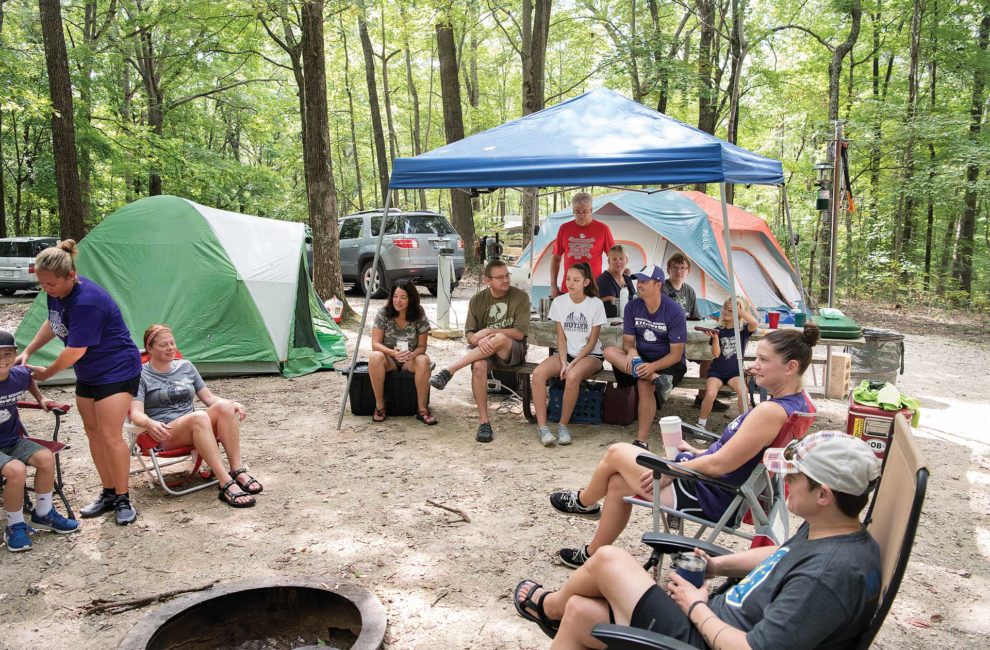Hoosier National Forest: Camping

Camping in Hoosier National Forest Photography by Tony Valainis
The Experience
The camper van pulls off the lonesome county road. After the gravel dust settles and the engine stops, the forest is completely silent … at least for a few moments. A black-and-white warbler soon begins his squeaky song anew, joined by a chorus of chirping crickets and a woodpecker playing breakneck percussion somewhere deeper in the woods.
The HNF isn’t your typical camping experience, where families are shoehorned in-between massive Class A motorhomes, and the only growl you hear is Def Leppard blaring from a neighbor’s F-150. There’s no swimming pool, no camp store with 20-pound bags of ice or glow sticks for the kids. Unless you’re at an equestrian campground, there are no bathrooms or other amenities, either.
Instead, you get solitude. Many campers choose to step off a trail and just set up a tent on whatever clear, level ground they can find. After the sun disappears below the tree line, campfires illuminate the eyes of opportunistic raccoons hovering nearby, hoping to snag any leftover morsels of food. With only a hint of light pollution on the horizon, you can lean back in your folding chair and marvel at the countless stars overhead. Perhaps best of all, it’s free. It’s like a massive backyard for all Hoosiers.
How To Stay Wired
Cell service can be spotty throughout much of the HNF. Climbing to the top of a hill is often enough to get a signal from the nearest tower. But if you don’t want to take a chance and you’re near your vehicle, a signal booster like the WeBoost 4G-X RV mounted to it can work wonders. If you’re backpacking through the woods with a partner, a set of walkie-talkies like the Motorola T-800 Talkabouts is a great way to stay in contact if you accidentally get separated. Solo? A Spot Satellite Messenger allows you to share your GPS coordinates and ask for help.

Camping in Hoosier National ForestPhotography by Tony Valainis
How To Set Up Camp
Free dispersed camping—that is, outside a designated campground—is available across the HNF wherever there’s a pull-off. You can find maps of the campsites on websites like FreeCampsites.net and apps such as Campendium and AllStays. These are mostly primitive sites, meaning there aren’t hookups for electricity or water. (The privately owned Hardin Ridge campground offers plug-ins for a fee.) When it’s time to stop for the night, consider these tips from Rusted Moon Outfitters camping expert Tonya Furuhashi on how to do it right.
- Choose a campsite wisely. You want a level spot with limited undergrowth. Before pitching your tent, make sure there’s nothing sharp and pointy underneath. “And I like to stay as high as possible,” Furuhashi says. “That way if it rains, your site doesn’t flood. Plus, the view from a ridge is usually better.”
- If you’re going to have a fire, set it up well before dark. Clear all brush from the area and gather a circle of stones. But don’t consider it essential. “I’m not a huge fan of campfires myself,” Furuhashi says. “They cause pollution, and they can give your position away, which can be a problem if you’re a woman camping alone.”
- Survey the area for places to hang things: wet clothes, tools, and especially food. “It’s smart to take a reclosable bag for food scraps so you don’t have critters wandering through your campsite at night,” Furuhashi says.
- Get comfortable, but don’t plan to put down roots. In the HNF, you can only stay up to 14 days at a campsite.






